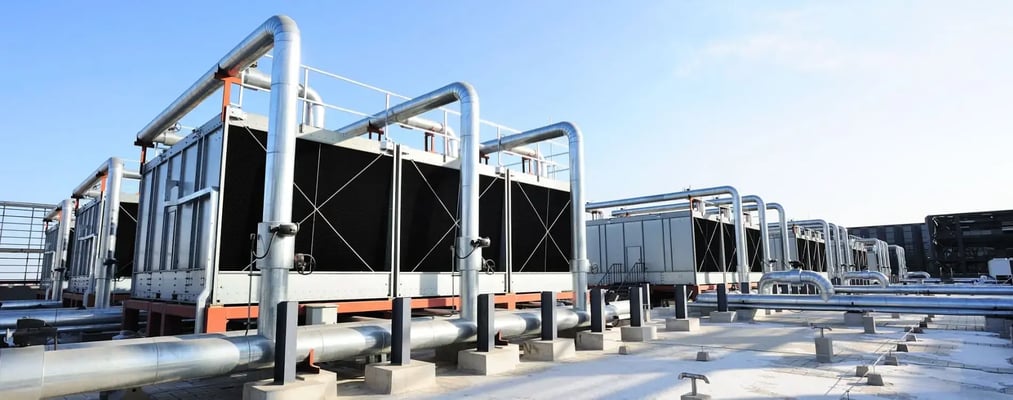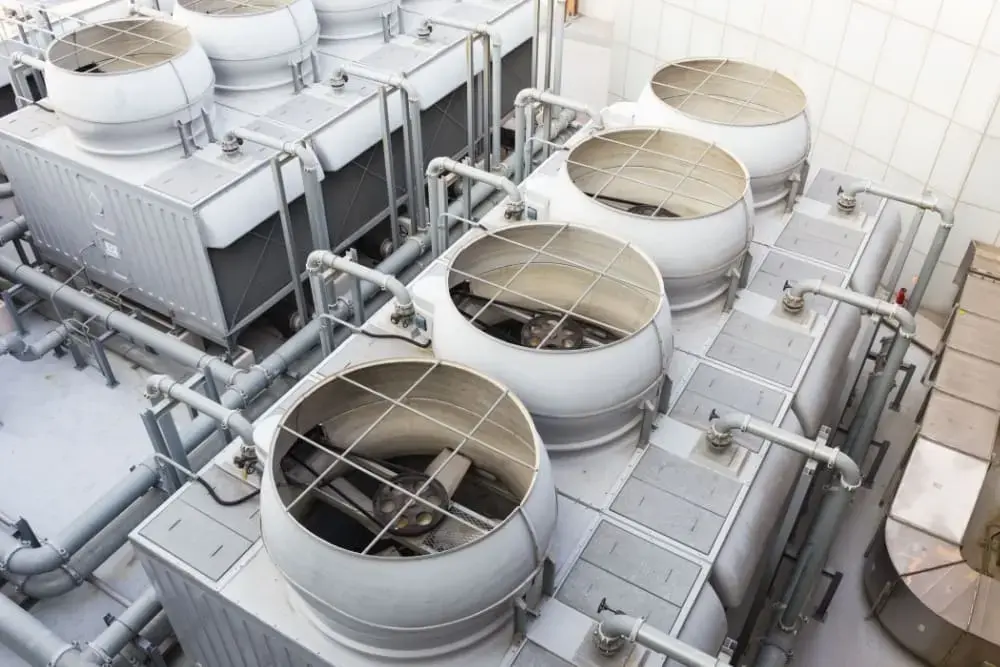
Cooling Towers
Cooling towers can remove large amounts of heat from a building, without using a lot of space. They are often used along with chiller plants in large constructions.
Energy Efficiency
Chillers with cooling towers are among the most efficient cooling systems.
Compact
Cooling towers fit on building rooftops and other areas with limited space.
High Capacity
Cooling towers can meet the needs of large commercial and industrial buildings.
Cooling Towers

Buildings often need to release large amounts of heat outdoors. Mechanical engineers frequently use cooling towers for this purpose, since they can remove large amounts of heat without using up an excessive amount of space.
In residential and commercial applications, most of the heat released comes from the operation of air conditioning systems, and some buildings also make ample use of refrigeration. In the case of industrial applications, it is often necessary to remove heat from manufacturing processes.
Cooling towers normally complement a major air conditioning system such as a chiller or a large heat pump:
- While the compressor units in heat pumps and chiller plants gather heat from indoor spaces, cooling towers are used to remove the heat from the compressors themselves.
- Since large HVAC units are often found indoors, while cooling towers are installed outdoors, both devices are normally connected with a water loop. The piping loop is equipped with a pump to keep the water in circulation.
- There are also special applications where a cooling tower can provide direct heat removal, without being connected to a chiller or heat pump.
Like with any piece of HVAC equipment, it is very important to use a cooling tower with the right capacity and performance features. A unit that is too small does not remove building heat fast enough, but purchasing an oversized cooling tower represents a waste of capital. By working with qualified MEP engineers, you can ensure your cooling towers and other HVAC components are properly sized and specified.
Main Types of Cooling Towers
Since water can absorb large amounts of heat when it evaporates, cooling towers normally use that physical principle to reject heat from a building. Units that use water evaporation to achieve their cooling effect are classified as either open circuit or closed circuit cooling towers.
Open circuit cooling towers discharge water carrying the building’s heat directly on the upper side of the unit. Water falls against an upward flow of air, which is established by a fan above the cooling tower. With the combination of forced airflow and water evaporation, the unit releases a large amount of heat in a relatively compact volume. However, there are two important considerations when using an open circuit cooling tower:
- The water is exposed directly to the atmosphere before it returns to the chiller, heat pump or process being cooled. Therefore, it must be treated constantly to prevent contamination with particles or bacteria. Legionella bacteria can be particularly dangerous for occupants and technical staff members, and the issue must be addressed immediately if they are detected.
- Since some water evaporates as it falls through the cooling tower, it must be replenished constantly to sustain the required flow through the HVAC unit or process being cooled.
Closed circuit cooling towers do not expose water to the atmosphere, and instead it circulates through a coil inside the unit.
- This cooling tower design also uses a fan to establish an airflow upward, but water is sprinkled from a separate source. As a result, the water that flows through the chiller plant or cooled processes is never exposed to the atmosphere.
- Closed circuit cooling towers are also known as adiabatic cooling towers, and they can achieve energy savings of around 30% compared with an open circuit configuration.
- These cooling towers also save water, by deactivating the sprinklers when airflow from the fan can provide enough cooling by itself.
An alternative system configuration to prevent water contamination is using an open circuit cooling tower with a plate heat exchanger.
- In this case, the water stream from the chiller or process does not reach the cooling tower directly, and instead it cools down in a heat exchanger connected to the cooling tower.
- This configuration requires an extra water loop and pump, but it prevents contamination with bacteria or particles.
If your building already uses a closed circuit cooling tower, there is no benefit from adding a plate heat exchanger, since the water is already isolated from the atmosphere. A heat exchanger is only a viable addition if you are using an open circuit configuration
There are also dry cooling towers, which are similar to closed circuit cooling towers but without the sprinklers for evaporative cooling. As you might expect, these cooling towers have a lower capacity than an equally-sized unit that also includes evaporative cooling.
Increasing the Energy Efficiency of Cooling Towers
Cooling towers have two components that consume a large amount of energy: the fan in the tower itself, and the pump that establishes water flow between the tower and indoor HVAC units or processes. Overall, a cooling tower system can represent 15% of total energy consumption in a chilled-water air conditioning system.
Like with many other HVAC components, an important requirement for efficient operation is having a cooling tower of the right capacity. However, there are additional measures that can be deployed to achieve the highest efficiency possible:
- Using high-efficiency motors to drive the pump and fan in the cooling tower system. NEMA Premium Efficiency motors are highly recommended, since they have the highest energy performance rating from the National Electrical Manufacturers Association.
- Adding speed control capabilities to these motors, by equipping them with variable frequency drives (VFD). A VFD can lower the speed of a fan or motor under partial load conditions, achieving a drastic reduction in energy expenses.
Under some climate conditions, it is possible to use a waterside economizer to increase the efficiency of a chiller or heat pump. When weather conditions are adequate, a waterside economizer can assume a portion of the space cooling load, reducing the electricity consumed by chillers or heat pumps.
Space cooling systems that combine chiller plants or heat pumps with cooling towers tend to offer the highest efficiency among all air conditioning options. However, it is important to make sure all systems elements are properly sized and configured. Having the most efficient space cooling solution in the market only guarantees top performance if all system elements are operating correctly.
Professional MEP engineers can analyze your project to determine the HVAC configuration according to your needs. Cooling towers are normally effective as part of chilled water systems in large buildings.
